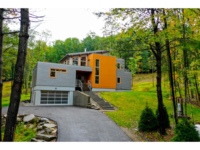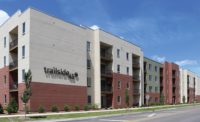A Cladding Conundrum: EIFS versus Brick






As a continuous insulation system, EIFS has the unique ability to provide a level of thermal efficiency that no other cladding system can duplicate. With fewer transitions and fewer penetrations throughout the system, EIFS prevents heat loss through walls. While brick is a quality cladding product, insulating benefits and energy-efficiency of EIFS are superior. From performance to overall environmental impact, EIFS continues to provide cladding qualities that competitors just can’t match.
EIFS Construction
The basic construction of an EIFS is the basis of its superior insulating properties. It is comprised of a polystyrene insulation board secured to the exterior wall with an adhesive, then reinforced with an acrylic plaster and fiberglass mesh on top, and finished with an acrylic and polymer coat that is both colorfast and crack-resistant. EIFS serves as a continuous insulation system, which helps reduce building operation costs.
Cost Efficiency
EIFS construction results in a cost-effective, highly insulating building envelope that reduces energy consumption⁵, offering R-values up to 25.1 Thermal bridging contributed by brick ties and lintels is significant. When compared to the maximum R-value for brick at 12, EIFS offers two to three times the typical insulating values found in brick-clad structures.1 Over a 21-month period, EIFS delivers roughly a 28 percent reduction in energy costs versus brick, for an annual savings of $1,089 ($90/month).⁴ In commercial construction, a reduction of this significance in base heating or cooling demand may make it possible to downsize HVAC systems, reducing initial costs and improving energy efficiency⁵ and environmental impact.
It is also important to consider the cost of materials and installation when comparing exterior cladding. EIFS is one of the most economical systems available, with an estimated material cost per square foot at $0.86 and installation cost of $5 to $6, which compares with the cost per square foot for brick at $1.25 with an installation cost of $8.50.1
EIFS also provides several other advantages over brick construction. EIFS walls are thinner than those made using brick. On average, brick is 35/8 inch thick with a 2 inch airspace. Buildings made using EIFS have more interior space for a given building size. And, with fewer points of entry for outside moisture, EIFS are less susceptible to damage that can result from moisture penetration into the cladding system. The porous nature of brick, on the other hand, absorbs and holds water.1
The lighter weight of EIFS materials means a lower global impact due to the lower fossil fuel requirements for shipping.2 The global warming impact3 (g of CO2/per unit) for EIFS is assessed at 1771 vs. 8303 for brick. Fossil Fuel Depletion3 (megajules per unit) for EIFS is measured at 3.62 vs. 26.57 for brick.
With lower material costs and greater energy savings, EIFS is an excellent choice for exterior cladding in both commercial and residential applications.
References
- “Sto EIFS Beat Brick … Layer by Layer.” Build Site. Sto Corp StoTherm EIFS, n.d. Web. http://www.guildsite.com/pdf/stocorp/Sto-EIFS-Beat-Brick-layer-by-layer-Comparison-Chart-B7896.pdf.
- “Sustainability Brick vs. Other Exteriors.” General Shale. Engineering Services, 07 Mar. 2013. Web. https://www.generalshale.com/resources/files/8aebb436-cfdb-4507-9432-e68207025c1f.pdf
- “This is What You See. This is What You Get.” Dryvit Systems, Inc. Dryvit Outsulation Systems, 2011. Web. http://www/dryvit.com/fileshare/doc/us/description/ds261.pdf
- “Energy Usage Analysis – EIFS vs. Brick.” EIFS Industry Members Association. MoistureBond Warranty, n.d. Web. http://www.eima.com/pdf/Energy%20Usage.pdf
- “EIFS, Architecture, and the Sustainable Design Revolution.” Richard Martens, LEED, AP, Web. http://www.wbdg.org/resources/eifs_as.php
Looking for a reprint of this article?
From high-res PDFs to custom plaques, order your copy today!









